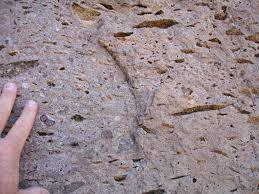|

Fiamme are lens-shapes, usually millimetres to centimetres in size, seen on surfaces of some volcaniclastic rocks. They can occur in welded pyroclastic fall deposits and in ignimbrites, which are the deposits of pumiceous pyroclastic density currents. The name fiamme (or fiamé) comes from the Italian word for flames, describing their shape. The term is descriptive and non-genetic.
Fiamme are most typical of welded lapilli-tuffs and are commonly found in association with eutaxitic textures, best seen under the microscope.
Some fiamme represent fragments of volcanic ejecta, often pumice lapilli that have been flattened by compaction and/or shear. Some fiamme are formed from flattened hot, relatively low viscosity, high porosity fragments of volcanic glass or pumice. But this is not the only way they can form: they can also form when pumice lapilli are altered to clay and compact during diagenesis; and fiamme are also widely reported in viscous lavas (andesites to rhyolites) where they form by shear-induced autobrecciation of pumiceous or obsidian zones, followed by shear and annealing of the fragments. Fiamme can also result from patchy alteration and recrystalisation of volcanic rocks, or by patchy revesiculation of welded tuff matrix (especially in rheomorphic peralkaline tuffs).
Adapted from: Gifkins, C.G.; Allen, R.L.; McPhie, J. (2005) Journal of Volcanology and Geothermal Research, 142: p.29–47. doi:10.1016/j.jvolgeores.2004.10.012
At the coordinates you are looking for structures similar to these:

Answer the following questions to validate your FOUND It:
1- Are the fiamé vertical or horizontal?
2- Are they rectilinear or curved?
3- What is the maximum length of the fiamé?
|

Fiamme são formas lenticulares, geralmente com tamanhos entre poucos milímetros a vários centímetros, observadas nas superfícies de algumas rochas vulcanoclásticas. Podem ocorrer em depósitos de piroclásticos consolidados e em ignimbritos, que são os depósitos de correntes de densidade piroclástica pomes. O nome fiamme (ou fiamé) vem da palavra italiana para chamas, descrevendo sua forma. O termo é apenas descritivo e não genético.
Fiamme são mais típicos de tufos-lapilli soldados e são comuns em associação com texturas eutaxíticas, melhor vistas ao microscópio.
Alguns fiammes representam fragmentos de material vulcânico ejetado, muitas vezes lapillis de pedra-pomes que foram achatados por compactação e / ou cisalhamento. Alguns fiamme são formados a partir de fragmentos achatados de alta viscosidade, relativamente baixa viscosidade, de vidro vulcânico ou pedra-pomes. Mas esta não é a única maneira que eles podem se formar: também podem se formar quando lapilli de pedra-pomes são alterados para barro e compactos durante a diagénese; e fiamme também são amplamente relatados em lavas viscosas (andesitos a riólitos), onde se formam por auto-brechificação induzida por cisalhamento de zonas de pomes ou obsidiana, seguido por cisalhamento e reccristalização dos fragmentos. O fiamme também pode resultar de alterações irregulares e recristalização de rochas vulcânicas, ou por uma remodelação irregular da matriz de tufos soldados (especialmente em tufos peralcalinosos reomórficos).
Adaptado de: Gifkins, C.G.; Allen, R.L.; McPhie, J. (2005) Journal of Volcanology and Geothermal Research, 142: p.29–47. doi:10.1016/j.jvolgeores.2004.10.012
Nas coordenadas da cache procura estruturas semelhantes a estas (ver infra):

Responde às seguintes perguntas para validar o teu registo:
1- Os fiamé são verticais ou horizontais?
2- Eles são rectilíneos ou curvos?
3- Qual o comprimento máximo do fiamé?
|